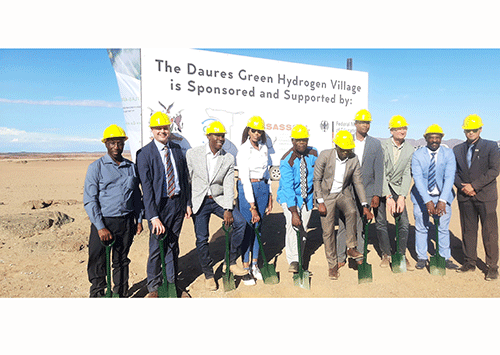DAURES – Namibia cemented itself as a force to be reckoned with as the country took the first step to make green hydrogen production a reality. The country on Monday afternoon launched the first phase of the Daures Green Hydrogen Village in the shadows of the Brandberg mountains.
The Daures Green Hydrogen Consortium secured a N$220-million grant from the German Federal Ministry of Education and Research (BMBF) to implement a Daures Green Hydrogen Village hydrogen project.
At least N$200 million will be spent during the first phase when the dry mountainous area, will see the rise of accommodation facilities, an eco-lodge, an onsite laboratory as well as a training facility for research and training of locals and students.
The project is expected to be carried out in four phases and will provide at least 100 jobs during the construction of the first phase and over 1 000 jobs once completed.
Speaking during the ground-breaking ceremony, CEO of the consortium, Jerome Namseb said during the first phase, they also envisaged setting up a wind farm, a solar plant, warehouses for storage of agricultural products as well as a climate-controlled green and seedling houses.
“We anticipate generating hydrogen in the fourth quarter of 2023 and commission those assets in early 2024. The importance of this funding is significant because it will enable the Daures Green Hydrogen Village to work keenly and sternly towards the goal of achieving green ammonia and green hydrogen production by December 2023,” he said.
The project will go live within the next 12 months, Namaseb explained. According to him, the Daures project is a perfect example of what can be achieved when the private sector, community and government work together.
“We are grateful to be the recipient of this project and the relationship between Namibia and Germany and Namibia that brought this concept to life. We are also grateful that the community was receptive and will become not only employees but shareholders of the project, an ecstatic Namaseb said.
Green hydrogen commissioner James Mnyupe also said the project dawned at a time when many expected it to materialise in 2030.
According to him, expectations were that this was a strategic opportunity, however, one with
low probability worth pursuing.
“Hence, we went around the world looking for partners who wanted to partner with us. Therefore, for a local company to receive millions to start work not in 2030, as many people predicted, speaks volumes to the public and private sector collaboration that made the project a reality,” he said.
Jane Olwoch from the Southern African Science Service Centre for Climate Change and Adaptive Land Management (SASSCAL), who oversees the project, said they
want to make sure this project succeeds only for Namibia but for the whole world.
“Southern Africa is the climate hotspot in all the areas making it perfect for such massive and impactful projects. We are very happy that it is happening in Namibia and grateful to the government and hydrogen council for providing the funding to make this happen,” she said.


